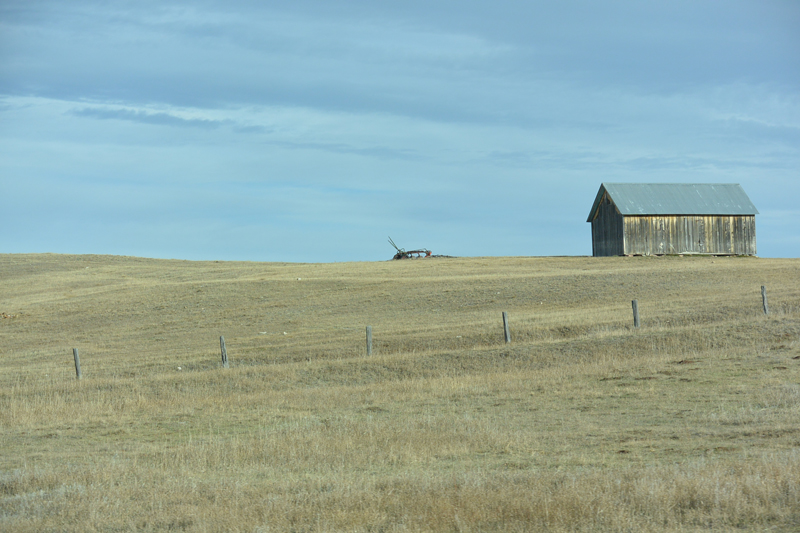
If you’ve been following my blog, you know that I recently spent some time in Hill City, South Dakota, visiting my friend, Barbara Majchrzak, at her High Country Guest Ranch and doing some writing.
Barb mentioned that a writers group she belongs to, the Bear Lodge Writers Group, had its monthly meeting in Sundance, Wyoming this week and wondered if I would be interested in going.
Absolutely.
Wyoming, a word which originally meant, “at the big river flat,” is so much more that its definition. It’s vast enormous, spacious, yet surprisingly interesting and beautiful.
The last time I visited Wyoming was in 1995 and my husband, three sons, and I, got caught in a hail storm on the prairie. To this day, I cannot believe the windows held as baseball-sized ice balls pelted our Ford Explorer.
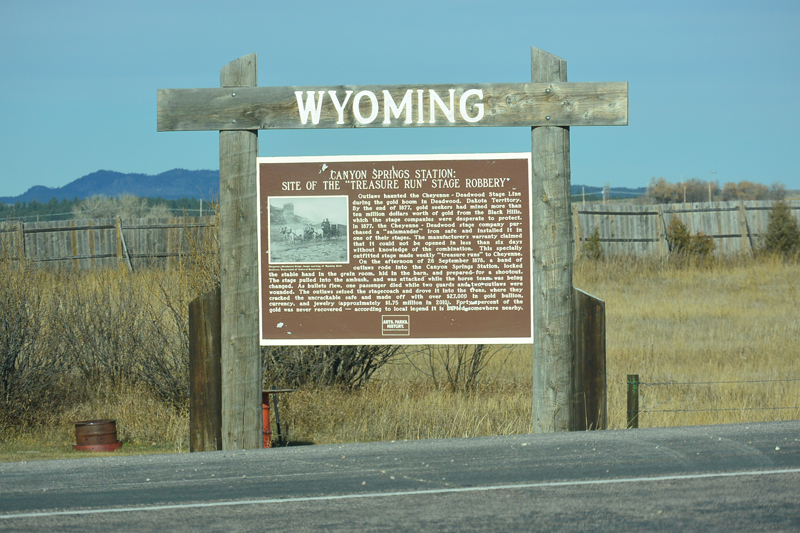 But Tuesday, the first of November, 2016, had nary a cloud in the sky and promised to be a beautiful day. I put on my cowboy boots, some turquoise, and we set off on our part-paved, part-gravel road 65-mile journey. I didn’t mind the gravel. In my mind’s eye, we were adventuring.
But Tuesday, the first of November, 2016, had nary a cloud in the sky and promised to be a beautiful day. I put on my cowboy boots, some turquoise, and we set off on our part-paved, part-gravel road 65-mile journey. I didn’t mind the gravel. In my mind’s eye, we were adventuring.
My secret bucket list held three things. Meet these fine writers Barb had talked about, see the town of Sundance where the writers were meeting, and along the way, to find something I wanted to photograph, such as an antelope.
The first twenty miles was paved road and Barb’s GMC Acadia hugged the 4,000-foot (give or take) Black Hills. While she drove round the bends, I looked for animals – some deer, an elk, anything, really.
I spied a yellow-bellied marmot, sometimes called a rock chuck. He was busy clawing at the ground looking for whatever marmots eat and we came upon him so fast I couldn’t get a picture. There were also good amount of mule and whitetail deer.
Soon we were on gravel. Minnesota’s gravel roads are mostly a brown-red mixture. South Dakota’s gravel is cream-colored. Vehicles traveling upon it disperse the residual dust, blanketing everything, the car, the tires, and settling upon the forest on both sides of the road in an ashen, ghost-like way. Barb pointed to the road-side Ponderosa pines. “They look like flocked Christmas trees, don’t they?”
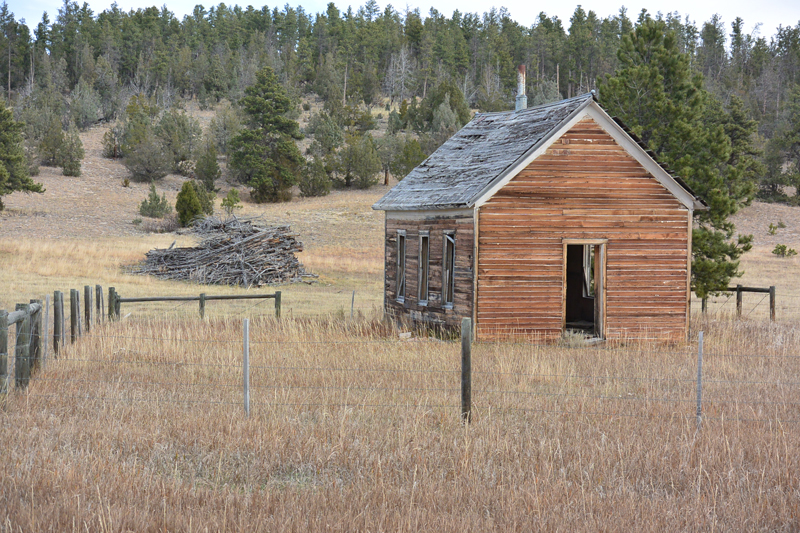
Home on the Wyoming prairie with a slash pile
I saw bunches of giant kindling – more like down trees – in big piles. They seemed strategically placed and I asked Barb about them. “They’re called slash piles. The Forest Service piles up downed trees so if a fire should start, the slash piles will control the speed of an advancing fire.”
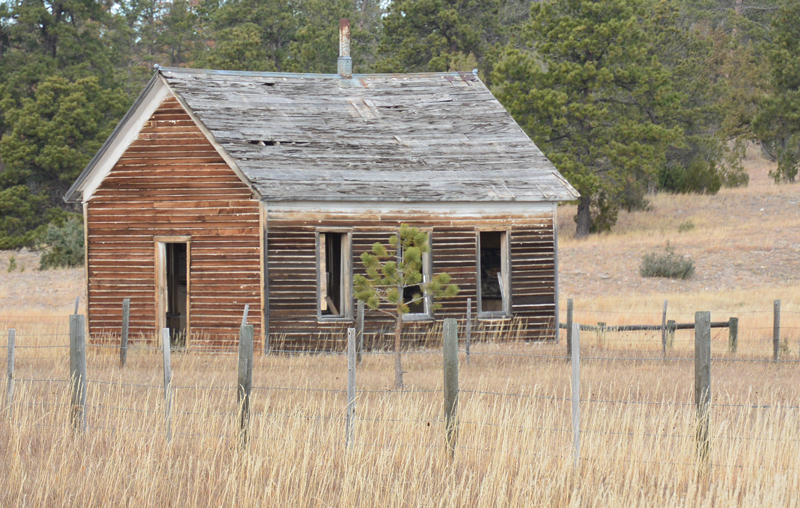 Several miles later, a small sign, situated on an incline to my right, let me know we were in Weston County.
Several miles later, a small sign, situated on an incline to my right, let me know we were in Weston County.
A couple of bends later and the dirt embankments changed from a chalky color to a sienna brown with hints of crimson.
“We’re in Wyoming now.” Barb said.
And on a paved road too.
Before me spanned thousands of acres of open, breathable space, where grasses ruffled and waved my stresses away in the wind.
Vast. Unspoiled. No building intrusions and concrete congestion, save for the occasional farm and the pavement.
We came upon a fence-like structure, two-by-fours crisscrossed in Xs, spanning sometimes 200 feet. Snow fences, I learned, meant to keep blowing snow from drifting onto the highway.
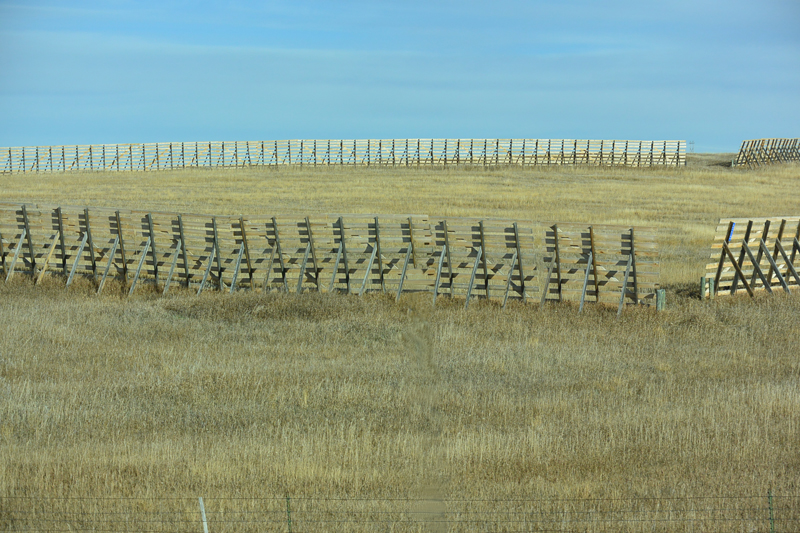
snow fences
I love everything about little derelict shacks and old homesteads. Who lived there. When did they come to Wyoming and why? If it’s a shack, what was stored there? Who built them? What is their story?
After turning just after Four Corners Country Inn, a few miles down Highway 585 we came upon an old two-story structure, I’m guessing from the early 1900s, that, by its new tin roof, is in the process of being restored.
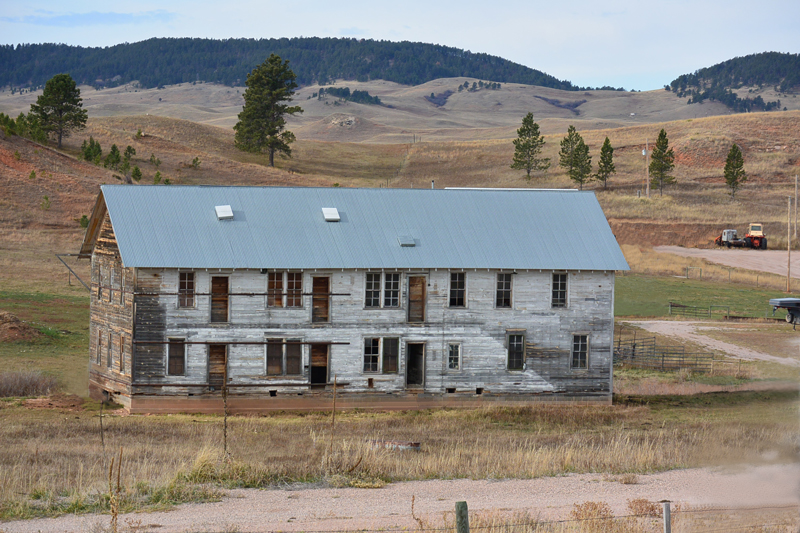 Barb and I wondered if maybe it was once a hotel or a boarding house. If only the walls could talk. What tales we’d hear. The property is near this real estate listing. Hoo-wee.
Barb and I wondered if maybe it was once a hotel or a boarding house. If only the walls could talk. What tales we’d hear. The property is near this real estate listing. Hoo-wee.
More miles of spacious beauty, of Angus cows on hillsides, spots here and there of leafless trees, and Ponderosas on the ranges.
I saw something leaping in the ditch on Barb’s side of the SUV. My heart raced. Really, was I really going to see pronghorn antelope in the wild?
“Want me to stop and go back?”
“Would you?”
“Absolutely. We have plenty of time.”
She turned the car around and the antelope had crossed to the other side of the highway, and were stopped, looking at me.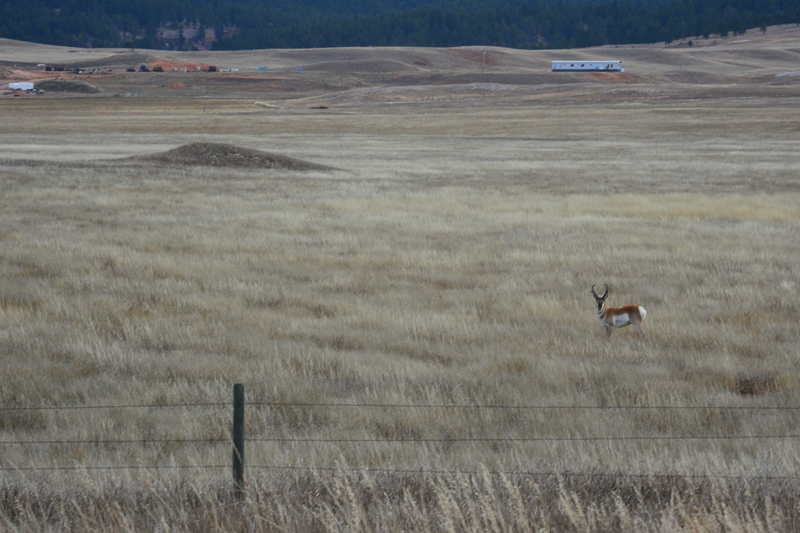 The three of them.
The three of them.
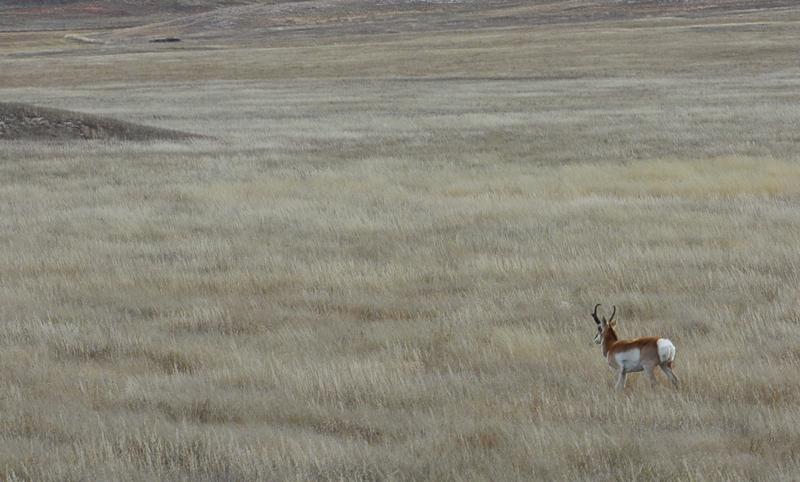 In the distance, more movement.
In the distance, more movement.
 Thirty movements, to be exact, walking, running, grazing, roaming – giving me and Barbara a private visual concert of their existence. It was hard, so hard, to drag ourselves away from being in their presence.
Thirty movements, to be exact, walking, running, grazing, roaming – giving me and Barbara a private visual concert of their existence. It was hard, so hard, to drag ourselves away from being in their presence.
But we had a place to be. The Sundance library called.
We arrived in Sundance forty minutes early, each sitting “in jail” for a moment with the Sundance Kid.
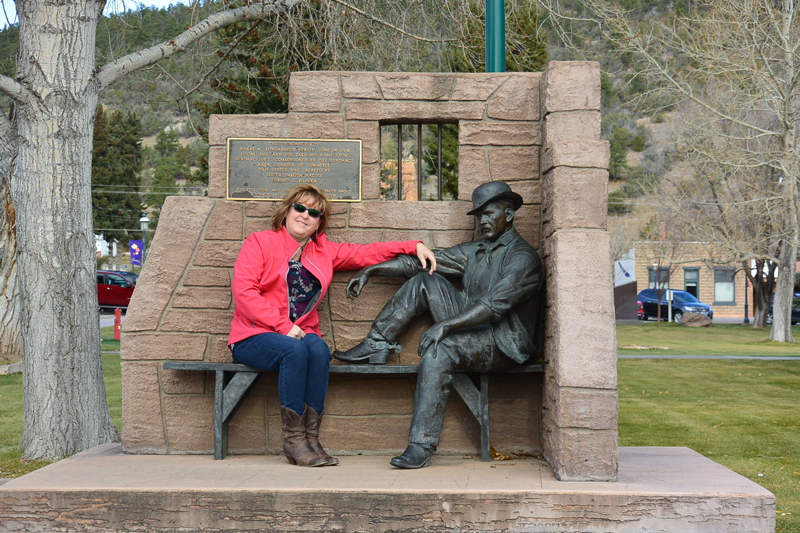
 We arrived at the library for the Bearlodge Writers meeting and I met some women writers of the west. Poets, fiction writers, essayists, non-fiction story writers – the eight women around the table wrote all kinds of words. I met Patricia Frolander, Wyoming’s 2011 Poet Laureate, listened to beautiful, well-crafted stories and moving poems, stories about the prairie, about Native Americans. My favorite was a poem by Katie, whose granddad was an irrigator, a new term to me, around 1927, who dug ditches and named them and passed the tradition and love of doing so down to his granddaughter. Just fascinating stories.
We arrived at the library for the Bearlodge Writers meeting and I met some women writers of the west. Poets, fiction writers, essayists, non-fiction story writers – the eight women around the table wrote all kinds of words. I met Patricia Frolander, Wyoming’s 2011 Poet Laureate, listened to beautiful, well-crafted stories and moving poems, stories about the prairie, about Native Americans. My favorite was a poem by Katie, whose granddad was an irrigator, a new term to me, around 1927, who dug ditches and named them and passed the tradition and love of doing so down to his granddaughter. Just fascinating stories.
Time spent with these ladies made me wish I could be a monthly part of their group. Their writing rustled up within me the desire to write well and good stories and to put down long-gone but remembered ways of life before they become derelict memories. I so enjoyed these writers and what their stories said about life. I loved that we were seated at a table surrounded, floor to ceiling, by others’ books and stories about this beautiful state of Wyoming.
Reluctantly the meeting came to an end and Barbara and I headed back to Hill City. As we did, we saw in the distance a controlled burn. After driving on these gravel roads, mile after mile of Ponderosa pines in southwestern South Dakota, one can see the danger of a forest fire.
Thanks, Barbara, for another awesome adventure!
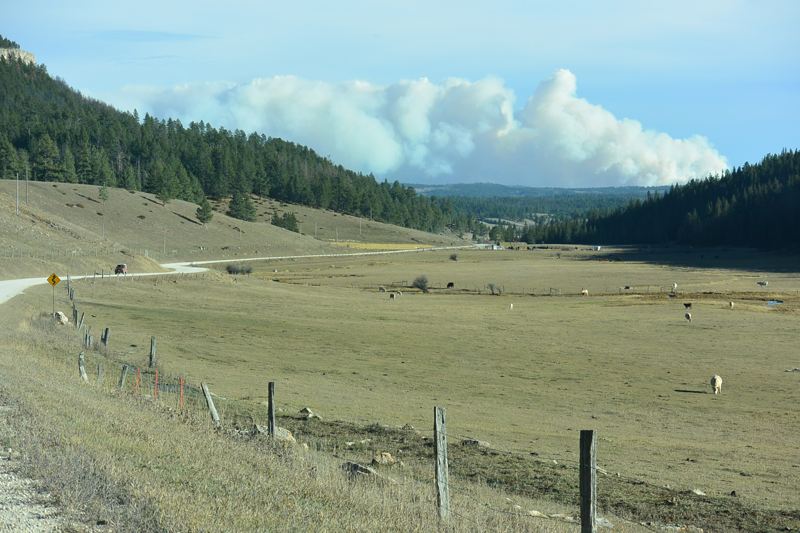
side Ponderosa pines. “They look like flocked Christmas trees, don’t they?” They did!
I saw bunches of giant kindling – more like down trees – in big piles. They seemed strategically placed and I asked Barb what they were. “They’re called slash piles. The Forest Service piles up downed trees so if a fire should start, the slash piles will control the speed of an advancing fire.”
Several miles later, a small sign, situated on an incline to my right, let me know we were in Weston County.
At the next bend, the dirt embankments changed from a chalky color to a sienna brown with hints of crimson.
“We’re in Wyoming now.” Barb said.
And on paved road too.
And just like that, the road bends were gone.
Before me spanned thousands of acres of open, breathable space, where grasses wave your stresses away in the wind.
Vast. Unspoiled. No building intrusions and concrete congestion, save for the occasional farm and the pavement.
We came upon another fence-like structure, two-by-fours, crisscrossed in Xs, spanning sometimes 200 feet. Snow fences, to keep lowing snow from drifting onto the highway.
I love everything about little derelict shacks and old homesteads. Who lived there. When did they come to Wyoming and why? If it’s a shack, what was stored there? Who built them? What is their story?
At about ____, we came upon an old two-story structure, I’m guessing from the early 1900s, that by its new tin roof, is in the process of being restored. Barb and I wondered if maybe it was once a hotel or a boarding house. If only the walls could talk. What tales we’d hear.
More miles of spacious beauty, of Angus cows on hillsides, spots here and there of leafless trees and Ponderosas on the ranges.
I saw something in the ditch on Barb’s side of the SUV, heaping. My heart raced. Really, was I really going to see antelope in the wild?
“Want me to stop and go back?”
“Would you?”
“Absolutely. We have plenty of time.”
She turned the car around and the antelope had crossed to the other side of the highway, and were stopped, looking at me. The three of them. In the distance, more movement. Thirty movements, to be exact, walking, running, grazing, roaming – giving me and Barbara a private virtual concert of their existence. It was hard, so hard, to drag ourselves away from being in their presence.
But we had a place to be. The Sundance library called.
We arrived in Sundance forty minutes early, each sitting “in jail” for a moment with Billy, the Sundance Kidd.
We arrived at the library and I met the women writers of the west. Poets, fiction writers, essayists, non-fiction story writers – the eight woman around the table wrote all kinds of words. I met ne of Wyoming’s Poet Laureates, listened to beautiful, well-crafted stories and moving poems, stories about the prairie, about Native Americans, of a granddad who was an irrigator around 1927, who dug ditches and named them and passed the tradition and love of doing so down to his granddaughter. Time spent with these ladies made me wish I could be a monthly part of their group. Their writing rustled up within me the desire to write well and good stories and to put down long-gone but remembered ways of life before they become derelict memories. I so enjoyed these writers and what their stories said about life. I loved that we were seated at a table surrounded, floor to ceiling, by others’ books and stories about this beautiful state of Wyoming.
About Julie Saffrin
Julie Saffrin is the author of numerous published articles and essays. Her latest book, BlessBack: Thank Those Who Shaped Your Life, explores the power of gratitude and offers 120 creative ways to journey toward positive, lasting change.
You are a writer! Being among all those writers must have filled your soul. So glad you were able to experience such joy. What a beautiful part of the country. Thanks for sharing.
Thanks, Gail. It really was a learning experience, both in discovering external surroundings and internal processing of ideas.
What an experience! And what a beautiful way with words you have, Julie. I especially loved, “Their writing rustled up within me the desire to write well and good stories and to put down long-gone but remembered ways of life before they become derelict memories.” Follow that desire, lady!
Thanks, Julie, for your kind words of encouragement.
Fun to read of your adventures in Wyoming. Thanks for sharing
Thanks, Steve. Hope that rotator cuff is healing.
So glad you had this trip to refresh and inspire your soul!
Thank you, Joy. And you are right about coming home inspired and refreshed. This getaway, particularly, cleared my head and allowed me to concentrate.